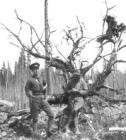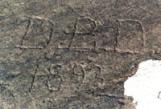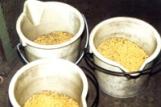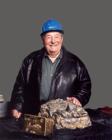1
The first indication of Red Lake’s mineral potential came from soapstone samples in the area. Robert Bell and Alfred Selwyn, geologists with the Geological Survey of Canada, were first on the scene.In 1872, the two men began a survey of Northwestern Ontario. While at Lac Seul, their Native guides showed them samples of soapstone rock from Red Lake. As any geologist will tell you, gold is often found near soapstone.
Little did they know that their discovery would turn into the gold jackpot that it is today.
3
Twenty-one years after Bell and Selwyn were sent in, the Geological Survey of Canada sent D.B. Dowling to the area.Dowling felt that Red Lake had high mineral potential, but didn’t find any specific deposits. Although this was surely not the outcome he had hoped for, Dowling carved his initials on soapstone at the mouth of Pipestone Bay, at the west end of Red Lake.
This was a common practice of many early prospectors. Many of their markings can be found carved in stone around the area.
4
The first prospectors to find gold in Red Lake, found it under the roots of this upturned tree.25 June 1925
Red Lake, Northwestern Ontario, Canada

5
Dr. E.L. Bruce was the next geologist to survey the area. His report, published in 1924, stated that “quartz veins (found at Red Lake) contain visible gold in quantities.”After reading his report, Ray Howey, George McNeely and Lorne Howey, prospectors from Cobalt, Ontario, traveled to Red Lake. On June 25, 1925, under the roots of an upturned tree, they discovered a major vein on the shores of Red Lake. This discovery triggered the last great gold rush in North America.
7
More than 3,000 people converged on Red Lake at the height of the gold rush os 1926. During the depression, businesses around the world were struggling to survive, but Red Lake’s economy was booming with several mines opening up in the area between the years of 1935 to 1940: McKenzie Gold, Goldshore, Madsen, Cochenour Willians and McMarmac.Not all times were prosperous, though. The Red Lake District suffered a series of blows in the early ’40s that nearly turned it into a ghost town. Gold ran out at both the McMarmac and Gold Eagle Mines, causing each to close down. Next, a shaft pillar collapsed and the ground caved in at the Howey Mine in Red Lake. It, too, shut down, leaving hundreds of people unemployed.
Businesses went bankrupt and several left the area. However, Red Lake’s good luck would return.
9
First, the Dickenson Mine was discovered, then George Campbell and his guide, Jacob Hager, found the mother lode next door. By 1949, both the Dickenson and Campbell Mines were in full production.11
The Campbell Mine, now owned by Placer Dome International, celebrated its 50th anniversary of continuous production in 1999 and poured its 10 millionth ounce of gold in April 2000. As the largest employer in the area, the Campbell Mine employs 460 full-time and contract employees.The Dickenson Mine, owned today by Goldcorp, announced the discovery of a new high-grade gold zone at the lowest levels of the mine. This discovery occurred 48 years after the mine began production, at a time when the mine had a questionable future because of declining reserves and increasing production costs. Following the new discovery in 1995, one of the highest-grade gold deposits in the world, Goldcorp rebuilt the mine and modernized its operation.



